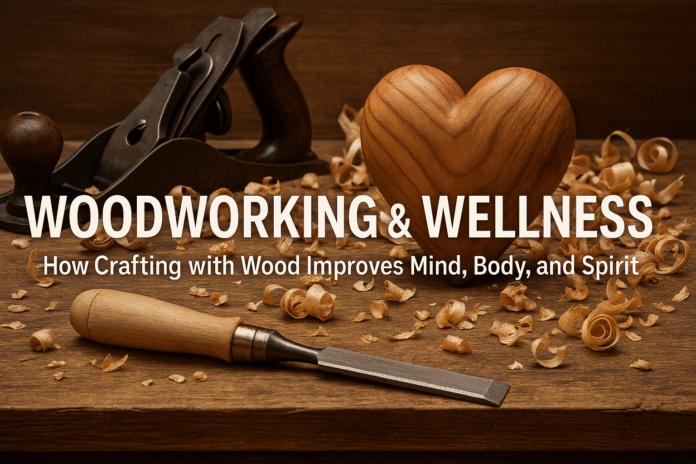Woodworking as a Path to Wellness: How Crafting with Wood Heals the Mind, Body, and Spirit
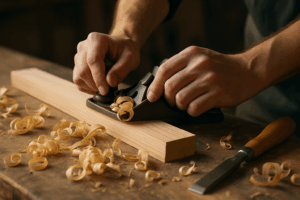
Woodworking has always been more than a craft. For many of us, it becomes a refuge—an activity that pulls us back into our center, slows the world down, and grounds us in the rhythm of our own hands. The existing article in this category beautifully captures this truth: the workshop is a sanctuary, and working with wood is a form of self-care.
This post continues that theme and expands it, showing how woodworking can be intentionally used as a wellness practice. Whether you are sanding a simple board or designing a complex piece of furniture, the process can offer profound benefits for your mental and physical well-being. And as this category grows, it can become a cornerstone of the entire website—one that reflects not only the craft, but the deeper impact it has on the lives of those who practice it.
The Deep Connection Between Woodworking and Wellness
A Craft That Returns Us to Ourselves

Woodworking forces us to slow down. Every measurement, every cut, every adjustment requires presence. Unlike the digital world—fast, noisy, and demanding—woodworking offers quiet spaces between each step. These pauses are not empty—they settle the mind.
Wood is also alive. It holds warmth. It holds history. It holds memory.
Working with wood reconnects us with something primal—something older than machines, older than electricity, older than the frantic pace of modern life. Woodworking is one of the earliest human skills, and when we practice it, we tap into that ancestral knowledge and bring it forward into our own lives.
An Antidote to Modern Stress
Many people live with a constant undercurrent of tension. Work, screens, noise, expectations—they all pile up. Woodworking disrupts that cycle. It requires our full focus, and that focus becomes a form of meditation in motion.
- The sound of the plane gliding across a board
- The smell of fresh shavings
- The tactile feedback of a sharp chisel
- The repetitive rhythm of sanding
These sensory elements create an environment where stress dissolves naturally because the mind is anchored to the present moment.
Mental & Emotional Benefits of Woodworking
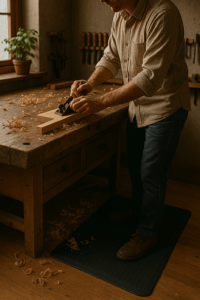
1. Mindfulness Through Motion
Mindfulness is often associated with sitting still, but for many people, stillness is hard. Woodworking provides an alternative—a mindful state achieved through movement, rhythm, repetition, and attention.
Every task becomes an opportunity for mindfulness:
- Setting up a cut
- Sharpening a tool
- Applying finish
- Aligning grain patterns
Each step draws the mind out of anxiety and back into awareness.
2. A Creative Outlet that Strengthens Emotional Health
Creativity is healing. It gives us agency, expression, and a sense of purpose.
When you build something, you transform raw material into something meaningful. You take an idea from your mind and make it real. This process:
- Boosts confidence
- Reduces negative rumination
- Provides a sense of achievement
- Builds emotional resilience
And unlike many creative hobbies, woodworking leaves you with a physical object—something useful and beautiful—that reinforces the positive emotions associated with creation.
3. A Healthy Way to Process Emotions
Many woodworkers describe the shop as the place where they sort out their thoughts. The rhythmic nature of shaping wood creates space for internal sorting. Tough emotions can be worked through without force—simply by doing, creating, and being with the material.
Physical Wellness Benefits
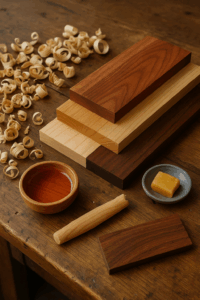
1. Encourages Movement
Woodworking keeps the body active in a natural way:
- Lifting
- Reaching
- Standing
- Bending
- Fine motor work
You are not simply exercising—you are engaging your body in meaningful, varied movement.
2. Strengthens Hands and Dexterity
Hand tools in particular sharpen motor skills and strengthen the small muscles in the hands and wrists. This can improve grip strength, joint stability, and long-term mobility.
3. Improves Sleep
The combination of:
- Physical movement
- Mental engagement
- Emotional grounding
…leads to better sleep quality. When the body is satisfied and the mind is calm, the nervous system shifts into rest mode more easily at night.
Why Wood Is Therapeutic by Nature
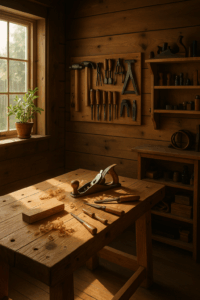
Working with wood is different from working with plastic, metal, or stone. Wood carries warmth and variation. Its grain tells a story. Its imperfections create character. Every piece is different and must be approached on its own terms.
Wood also creates a form of biophilic connection—a psychological response humans experience when interacting with natural materials. Studies show that natural textures reduce stress, lower blood pressure, and improve overall well-being.
When you bring wood into your daily life, whether by building or by using wooden objects, you’re reinforcing that connection.
Tools, Materials, and Practices That Support Wellness
This section naturally opens doors for affiliate products. Everything fits organically because these tools enhance the woodworking-wellness experience.

1. High-quality hand tools that encourage slow, mindful work
- Hand planes
- Japanese pull saws
- Sharpening stones
- Wooden handles and chisels
These tools slow you down, deepen focus, and make the craft more meditative.
2. Aromatic, calming woods
Some woods even provide subtle aromatherapy:
- Cedar
- Pine
- Juniper
- Sandalwood accents
- Walnut oils
These materials can inspire articles on choosing woods for wellness projects.
3. Workshop wellness essentials
- Anti-fatigue mats
- Air purifiers
- Soft lighting
- Dust collection systems
- Ambient workshop sound systems
Products that make the shop more comfortable also boost well-being.
4. Finishes that connect you to natural elements
- Tung oil
- Linseed oil
- Beeswax
- Natural blends
These finishing oils and waxes are tactile, safe, and satisfying to apply—great for affiliate recommendations.
How Woodworking Strengthens Purpose, Identity, and Community
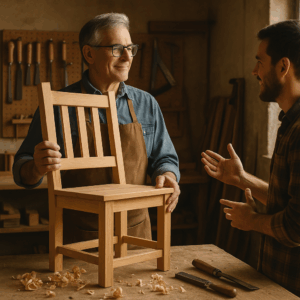
Purpose
The act of creating something useful with your hands gives you a sense of mission. You’re repairing, building, improving, contributing. This strengthens identity and resilience.
Identity
In woodworking, your identity grows with your skills. You begin as a beginner, then a student, and eventually an artisan. Each piece becomes a milestone in your growth.
Community
Sharing woodworking—teaching, gifting, posting, selling—creates bonds. Human connection is itself a major pillar of wellness.


